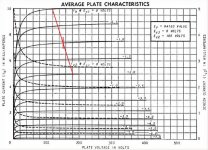damn! Just what I didn't need - a new concept....
Thanks Douglas. The OPTs are U/L tapped too!!!!
Sorry about that...
cheers,
Douglas
I recently scored some $15 NOS power transformers on Ebay to go with my $16 OPT's so I started thinking about how I would make an ultra cheap amp. Several combinations came to mind, but one of the leading contenders is a 6SJ7 - 6AV5 amp. The power transformers are supposed to be capable of powering a "100+ watt amp" at over 600 volts! The weight (10 pounds) looks about right. No UL taps, so no E-linear.
I'm assuming you're considering the current-mode driver setup, consisting of a pentode driver loaded by the plate feedback resistors.
6SJ7 driver looks pretty linear in the -1V Vg1/100Vg2 regime with about 2V P-P swing on the grid. The current swing is a little low, but with 6V6 outputs it should work fine with ca. 100K feedback resistors. With E-linear you would be using a fraction of that 100K or so based on the UL tap %age e.g maybe try 40K Rf with 40% taps. Either way will give you about 5mA Pk-Pk driver current swing with about 500V P-P output swing per side. Note: Using Elinear with 40% taps is nice here because at about 300V on the plate and 150 on the driver plate, you'll have 3.75mA across the feedback resistor. Another 40K to B+ of ca. 300V gives you 7.5mA idle current thru the driver.
6AC7 is not as linear but the gm is so high you would likely need to degenerate it with an unbypassed cathode resistor, which improves the linearity. You could also get away with more driver current but it's not needed.
I think I would go with the 6SJ7 personally. I might even pick up a few for experiments.
6V6 outputs won't be running at very high voltage, so I think you have a lot of flexibility to try different feedback connections.
You shouldn't need to use a lot of sand, but the LTP CCS is a no brainer.
I'm going with octal tubes in my current breadboard but using the 6V6 as a driver with 6L6 type outputs (also sweep tubes but with some different G2 arrangements).
Cheers,
Michael
6SJ7 driver looks pretty linear in the -1V Vg1/100Vg2 regime with about 2V P-P swing on the grid. The current swing is a little low, but with 6V6 outputs it should work fine with ca. 100K feedback resistors. With E-linear you would be using a fraction of that 100K or so based on the UL tap %age e.g maybe try 40K Rf with 40% taps. Either way will give you about 5mA Pk-Pk driver current swing with about 500V P-P output swing per side. Note: Using Elinear with 40% taps is nice here because at about 300V on the plate and 150 on the driver plate, you'll have 3.75mA across the feedback resistor. Another 40K to B+ of ca. 300V gives you 7.5mA idle current thru the driver.
6AC7 is not as linear but the gm is so high you would likely need to degenerate it with an unbypassed cathode resistor, which improves the linearity. You could also get away with more driver current but it's not needed.
I think I would go with the 6SJ7 personally. I might even pick up a few for experiments.
6V6 outputs won't be running at very high voltage, so I think you have a lot of flexibility to try different feedback connections.
You shouldn't need to use a lot of sand, but the LTP CCS is a no brainer.
I'm going with octal tubes in my current breadboard but using the 6V6 as a driver with 6L6 type outputs (also sweep tubes but with some different G2 arrangements).
Cheers,
Michael
Attachments
Last edited:
6sj7 ltp voltage amp/phase inverter to 6v6gta output. 7k primary opt. Happy to use sand anywhere.
I've got all the major bits - tubes and transformers.
Thoughts from the front seats?
The 6V6 sounds so good running open loop that I don't believe they need the added assistance from local NFB. The 6BQ6GA/GTB is another type with a similar harmonic profile. Open loop, these produce mainly h3 (push-pull, not SE) with very little higher order harmonics. Open loop, the sound is mainly overly aggressive, edgy, bright -- however, the pentode nastiness isn't evident unless you take 'em nearly to the point of obvious distortion.
The 6BQ6s needed just enough gNFB to take the edge off (no more than 6db(v) of gNFB; 12db(v) of gNFB gave a definite solid statey sound).
Other finals -- such as the 807 -- make a lot more higher order harmonics and definitely can benefit from local NFB.
Your best bet is to build the project, spend at least a week (preferably two) listening open loop before deciding on what you'll be needing to correct for whatever sonic deficits you can identify.
- Status
- This old topic is closed. If you want to reopen this topic, contact a moderator using the "Report Post" button.
- Home
- Amplifiers
- Tubes / Valves
- all-octal schaded pp
